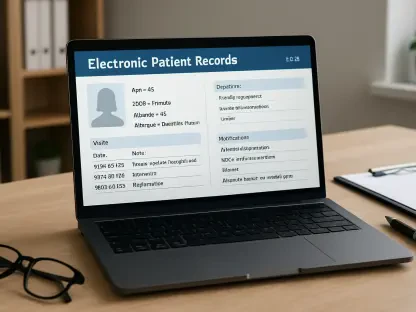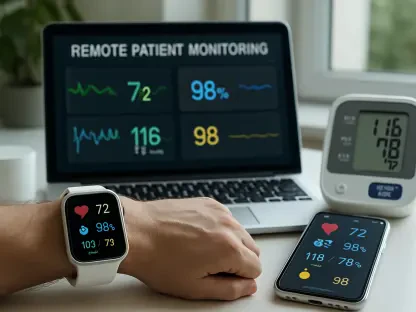Unveiling the Growing Threat of Payment Fraud in Healthcare
Imagine a healthcare system where billions of dollars in daily transactions are at constant risk, with fraudsters exploiting every vulnerability to siphon funds meant for patient care, creating a critical challenge for payers, providers, and patients alike. Payment fraud in the healthcare sector has surged, leading to devastating financial and operational consequences. The sophistication of fraud tactics has escalated, moving from simple forgery to intricate schemes like account takeovers, leaving organizations scrambling to protect their resources.
This pervasive threat not only drains financial assets but also undermines trust among stakeholders, making it a top priority for the industry. The scale of the issue is staggering, as fraudsters continuously adapt to bypass traditional defenses, targeting both digital and paper-based payment methods. With such high stakes, the need for robust prevention strategies has never been more urgent, pushing healthcare entities to modernize payment systems and integrate cutting-edge security measures.
The purpose of this guide is clear: to equip healthcare organizations with actionable strategies to combat payment fraud effectively. By addressing systemic vulnerabilities and adopting advanced technologies, the industry can safeguard transactions, preserve operational integrity, and maintain stakeholder confidence in an increasingly complex landscape. This roadmap offers a glimpse into transformative approaches that can turn the tide against fraud threats.
Understanding the Roots and Risks of Healthcare Payment Fraud
Payment fraud in healthcare is not a new phenomenon, but its evolution reflects a troubling shift from basic scams to highly coordinated attacks. Historical reliance on outdated methods, such as paper checks, has left the sector exposed, with 23% of healthcare and 30% of dental claim payments still processed this way. These manual systems are easily manipulated through theft or forgery, providing fraudsters with low-hanging fruit in an otherwise digital era.
Beyond outdated infrastructure, systemic issues like fragmented payment processes and high transaction volumes create additional blind spots. Modern fraud tactics, including phishing and business email compromise, exploit these gaps, often targeting unsuspecting staff or vulnerable data systems. The persistence of such risks is compounded by the sheer diversity of payment methods, each presenting unique challenges that overwhelm traditional detection methods.
The consequences extend far beyond financial loss, impacting every facet of healthcare operations. Fraud incidents lead to significant inefficiencies as resources are diverted to investigate and resolve issues, while regulatory penalties loom for non-compliance or payment errors. Reputational damage and strained provider relationships further complicate matters, highlighting why immediate action to address these root causes is essential for long-term stability.
Strategic Steps to Counter Payment Fraud in Healthcare
Step 1 – Transitioning from Paper Checks to Digital Payments
The continued use of paper checks remains a glaring vulnerability in healthcare payments, prone to forgery and theft with alarming ease. Transitioning to digital payment methods is a critical first step in reducing fraud risks, as these solutions offer enhanced security and streamline transaction processes. By eliminating paper-based workflows, organizations can close a major entry point for fraudsters.
Digital payments also bring efficiency gains, cutting down on manual processing times and reducing human error. This shift not only bolsters security but also aligns with industry trends toward automation and scalability. Healthcare entities must prioritize this transition to protect funds and build a more resilient payment framework.
Identifying Secure Digital Payment Platforms
Selecting the right digital payment platform is paramount to ensuring transaction safety. Platforms equipped with robust security features, such as encryption and real-time monitoring, provide a strong defense against unauthorized access and suspicious activities. These tools must be vetted for reliability to replace outdated methods effectively.
Beyond basic security, compatibility with existing systems and ease of use are key considerations. A platform that integrates seamlessly with healthcare workflows minimizes disruption while maximizing protection. Careful evaluation of vendor offerings ensures that the chosen solution meets stringent industry needs.
Overcoming Resistance to Digital Adoption
Resistance to abandoning paper checks often stems from familiarity or concerns about technology adoption. Educating stakeholders about the tangible benefits of digital payments, such as reduced fraud risk and faster processing, is essential to gaining buy-in. Clear communication can dispel myths and highlight long-term cost savings.
Addressing specific pain points, like training needs or initial setup costs, also helps ease the transition. Offering support through pilot programs or phased implementations can build confidence among staff and providers. Persistence in demonstrating value over time turns skepticism into advocacy for digital solutions.
Step 2 – Leveraging AI and Machine Learning for Fraud Detection
Artificial Intelligence (AI) and Machine Learning (ML) represent powerful tools in the fight against payment fraud, capable of identifying suspicious patterns in real time. These technologies analyze vast amounts of transaction data to detect anomalies that may indicate fraudulent activity, outpacing traditional manual reviews. Their proactive nature is a game-changer for healthcare organizations under constant threat.
By continuously learning from new data, AI and ML adapt to evolving fraud tactics, ensuring defenses remain relevant. This dynamic capability allows for early intervention, often before funds are lost, preserving financial resources. Implementing such advanced systems is a strategic move to stay ahead of sophisticated fraudsters.
Implementing Real-Time Monitoring Tools
Real-time monitoring tools powered by AI provide an immediate line of defense against fraudulent transactions. These systems flag unusual activities, such as sudden spikes in payment requests or mismatched account details, for further scrutiny. Their speed and accuracy minimize the window of opportunity for fraudsters to exploit vulnerabilities.
Integration of these tools into payment workflows ensures constant vigilance across all transaction points. Alerts can be customized to reduce false positives, focusing only on high-risk scenarios. Such precision enhances operational efficiency while maintaining a strong security posture.
Customizing Algorithms for Healthcare Needs
Generic AI solutions may fall short in addressing the unique challenges of healthcare payment systems. Tailoring algorithms to recognize sector-specific transaction patterns, such as recurring provider payments or seasonal claim surges, boosts detection accuracy. Customization ensures relevance in a highly specialized environment.
Collaboration with technology providers to fine-tune these algorithms is critical for optimal performance. Regular updates based on emerging fraud trends keep the system effective over time. This targeted approach maximizes the protective impact of AI within healthcare’s distinct operational context.
Step 3 – Strengthening Cybersecurity with Multi-Layered Defenses
Cybersecurity forms the backbone of any effective fraud prevention strategy, especially in a sector handling sensitive patient and payment data. Multi-layered defenses, including encryption and multi-factor authentication, create formidable barriers against unauthorized access. These measures are non-negotiable in safeguarding healthcare transactions.
Beyond protecting data, robust cybersecurity deters fraudsters by increasing the effort required to breach systems. Layered approaches ensure that even if one defense fails, others remain in place to mitigate risks. Committing to comprehensive security protocols is essential for maintaining trust and operational continuity.
Securing Data with Encryption and Tokenization
Encryption and tokenization are vital techniques for protecting payment information during transmission and storage. Encryption scrambles data into unreadable formats, while tokenization replaces sensitive details with unique identifiers, rendering stolen data useless to attackers. Together, they significantly reduce breach risks.
Implementing these technologies across all payment channels ensures consistent protection against cyber threats. Regular audits of encryption standards help identify and address potential weaknesses. Such diligence is crucial in a landscape where data breaches can have catastrophic consequences.
Enforcing Multi-Factor Authentication Protocols
Multi-factor authentication (MFA) adds an extra layer of verification, requiring users to provide multiple forms of identification before accessing payment systems. This could include passwords, biometric scans, or one-time codes, making unauthorized entry far more difficult. MFA is a proven deterrent against account takeovers.
Mandating MFA for all staff and vendors interacting with payment platforms minimizes internal and external risks. User-friendly implementation, such as mobile-based authentication, encourages compliance without hindering workflows. This additional safeguard is a cornerstone of modern cybersecurity in healthcare.
Step 4 – Integrating Systems for Seamless Fraud Prevention
Fragmented payment systems create silos that fraudsters exploit through unnoticed gaps. Integrating workflows, vendors, and compliance controls into a unified payment ecosystem enhances visibility and coordination, eliminating blind spots. A cohesive environment is fundamental to comprehensive fraud prevention.
Unified systems also streamline operations, reducing the complexity of managing multiple payment methods. This integration ensures that security measures and fraud detection tools work in tandem across all touchpoints. Building such a framework is a strategic investment in long-term resilience.
Building a Unified Payment Ecosystem
A unified payment ecosystem connects disparate processes into a single, secure platform, providing end-to-end oversight of transactions. This approach allows for real-time tracking of funds and immediate identification of discrepancies. Enhanced transparency is a powerful tool against hidden fraud.
Collaboration among stakeholders to design and implement this ecosystem ensures alignment with organizational goals. Scalability must be prioritized to accommodate growing transaction volumes without compromising security. Such a system fosters efficiency while fortifying defenses.
Embedding Compliance as a Protective Layer
Regulatory compliance, including adherence to standards like HIPAA and PCI, serves as an additional shield against fraud risks. Embedding these controls directly into payment systems ensures automatic alignment with legal and industry requirements. Compliance becomes a seamless part of daily operations rather than an afterthought.
Regular training on compliance updates keeps staff informed and vigilant against potential violations. Automated checks within integrated platforms further reduce the risk of errors that could lead to penalties. This protective layer reinforces the overall security framework effectively.
Key Takeaways for Tackling Payment Fraud
- Retire paper checks and adopt secure digital payment solutions to eliminate a major fraud vulnerability.
- Utilize AI and machine learning for real-time fraud detection and anomaly identification to stay ahead of threats.
- Strengthen cybersecurity with encryption, tokenization, and multi-factor authentication to protect sensitive data.
- Integrate payment systems to eliminate silos and embed compliance controls for comprehensive protection.
Looking Ahead: The Future of Fraud Prevention in Healthcare
The strategies outlined align closely with broader industry shifts toward digital payments and AI-driven security across various sectors. As transaction volumes in healthcare continue to grow, scaling defenses to match this expansion remains a pressing challenge. Staying proactive in adopting innovative solutions will be key to addressing these evolving demands.
Emerging fraud tactics will undoubtedly test the resilience of current systems, necessitating continuous adaptation. Collaboration among healthcare stakeholders, including payers, providers, and technology vendors, fosters a collective approach to building stronger safeguards. Shared insights and resources amplify the industry’s capacity to respond effectively.
Ongoing innovation in fraud prevention tools promises to further enhance protection over time. Investment in research and development ensures that healthcare remains at the forefront of security advancements. A commitment to vigilance and partnership paves the way for a more secure payment landscape in the years ahead.
Taking Action: Safeguarding Healthcare Payments Now
Reflecting on the journey through combating payment fraud, it became evident that immediate action was paramount for healthcare organizations. The steps taken to modernize payment systems and integrate advanced security measures proved essential in protecting billions in transactions. Each strategy implemented, from retiring paper checks to leveraging AI, played a vital role in fortifying defenses.
Looking back, the commitment to cybersecurity and unified systems stood out as a turning point in reducing vulnerabilities. Moving forward, healthcare entities must continue prioritizing innovation by exploring emerging technologies and refining existing protocols. Staying ahead of fraudsters demands an unwavering focus on scalability and adaptability in every payment process.
As a final consideration, fostering a culture of continuous improvement and collaboration emerged as the next critical step. Engaging with industry peers to share best practices and investing in staff training ensured that defenses remained robust against new threats. These proactive measures solidified trust among stakeholders and secured the financial integrity of healthcare operations for the long haul.









